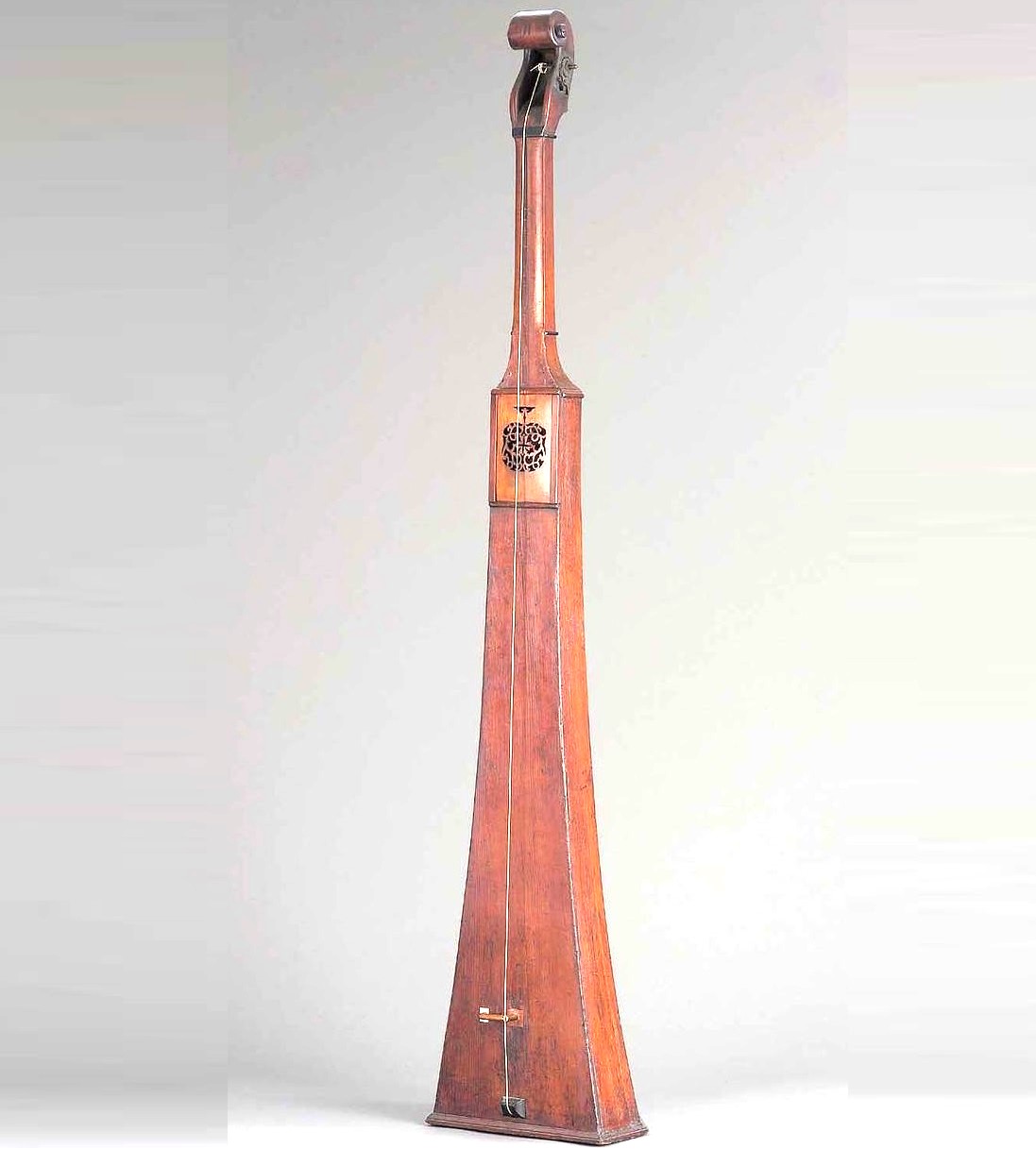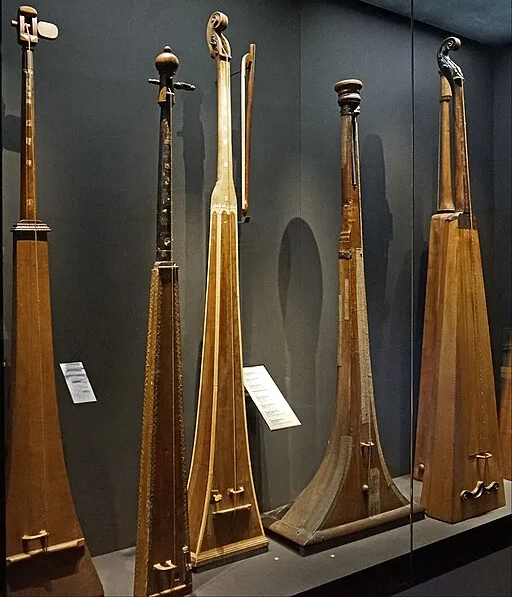Trumpet marine
Bowed Instruments
Europe
Between 1001 and 1900 AD
Video
The Trumpet Marine, also known as the Tromba Marina, is a fascinating and somewhat obscure musical instrument that was widely used during the medieval and Renaissance periods. Despite its name, it is not a brass instrument but rather a bowed string instrument that produces a sound reminiscent of a trumpet. The instrument consists of a long, narrow, triangular or cylindrical wooden body with a single string stretched from the top to the bottom. The sound is generated by bowing the string while lightly touching it to create harmonic overtones, and a special bridge design contributes to its characteristic trumpet-like timbre.
Type of Instrument
The Trumpet Marine belongs to the string family of musical instruments. It is a monochord instrument, meaning it typically has a single string, although some variations have included more. Despite its classification as a string instrument, its playing technique and timbre give it a close resemblance to a trumpet, which is why it was often used as a substitute for brass instruments in certain settings. It is typically played with a bow, and its unique bridge design allows it to create a buzzing sound similar to that of a brass trumpet.
History
The Trumpet Marine has an intriguing historical background, with its roots tracing back to Europe in the 15th century. It was primarily used in France, Germany, and Italy but gained popularity in various other European countries over the following centuries. The instrument is believed to have evolved from early monochord instruments and gained prominence in the late medieval and Renaissance periods.
During the 17th and 18th centuries, the Trumpet Marine saw its peak popularity, particularly in monastic institutions where women were not allowed to play actual trumpets due to social restrictions. Instead, they used the Trumpet Marine to imitate the sound of the trumpet in sacred and ceremonial music. The instrument gradually declined in use with the development of more sophisticated brass instruments, but it remains an object of historical and musical curiosity today.
Materials and Construction
The Trumpet Marine is made primarily of wood, with different types of hardwoods commonly used for its body and neck. The string was traditionally made from gut but later versions included metal-wound strings. One of its defining characteristics is its unique bridge, often made of wood with a small, free-moving foot that vibrates against the soundboard, creating a distinctive buzzing effect. The bow used for playing the Trumpet Marine is similar to that of a violin or viola, with horsehair stretched across a wooden stick. Some models also feature additional sympathetic strings to enhance resonance and projection.
Types of Trumpet Marine
Though the Trumpet Marine was typically a single-string instrument, variations existed throughout its history. Some of these include:
- Standard Monochord Trumpet Marine: The most common form, featuring a single gut string and a buzzing bridge.
- Double-String Trumpet Marine: Some versions included an extra string, often used to enhance the instrument’s resonance or projection.
- Modified Trumpet Marine with Sympathetic Strings: Some later models incorporated additional sympathetic strings beneath the main string to create a fuller sound.
- Extended-Length Trumpet Marine: Some variations were longer than usual, increasing the harmonic range and allowing for a deeper sound.
Characteristics
The Trumpet Marine, also known as the Marine Trumpet or Tromba Marina, is a unique medieval and Renaissance-era stringed instrument that produces a trumpet-like sound despite being a bowed monochord. It consists of a long, triangular wooden body with a single or sometimes multiple strings, usually tuned to a high pitch. The sound is created by bowing the single string, while a special vibrating bridge, called a “rattling bridge” or “tremolo bridge,” adds a buzzing effect, mimicking the timbre of a brass trumpet.
The instrument is typically played in a standing position, often resting against the player’s body. Its construction and playing technique made it a popular choice for convents and religious institutions, as it allowed nuns to perform trumpet-like music without using actual brass instruments, which were often considered inappropriate for them. Though it eventually fell out of common use, the Trumpet Marine remains a fascinating historical instrument known for its unusual sound production and distinctive shape.
Sound Production
The Trumpet Marine produces sound primarily through bowing. The player draws a bow across the single string while lightly touching it at different nodal points to create harmonics. The instrument’s special bridge plays a crucial role in generating its characteristic buzzing tone. The bridge, loosely attached to the soundboard, vibrates against it when the string is bowed, producing a sharp, brassy sound akin to a trumpet. The effect is further enhanced by the instrument’s long resonating body, which amplifies the sound.
Playing Methods
The Trumpet Marine, despite its name, is a bowed string instrument rather than a brass instrument. It is played by bowing a single thick gut string, which is stretched over a long, triangular wooden body. The player produces sound by lightly touching the string with their left-hand fingers at nodal points, similar to natural harmonics on other stringed instruments. The bowing technique involves applying varying pressure to create the instrument’s characteristic buzzing, trumpet-like sound. Additionally, the bridge is designed asymmetrically, with one foot unattached to the soundboard, allowing it to vibrate freely and produce a brassy, resonant tone. Some performers use a technique called “stopped playing,” where they press the string down to create more distinct pitches. Though primarily a monophonic instrument, advanced players can create subtle variations in tone by adjusting bow speed, pressure, and contact points.
Role in Music
The Trumpet Marine was primarily used in ceremonial and religious contexts. Since its sound closely resembled a trumpet, it was often employed in situations where brass instruments were either unavailable or deemed inappropriate. Some key roles included:
- Monastic Music: Used in convents where nuns were prohibited from playing actual brass trumpets.
- Court and Military Ceremonies: Sometimes used in royal or military settings as a substitute for real trumpets.
- Orchestral and Ensemble Use: Though not a mainstream orchestral instrument, it was occasionally incorporated into early Baroque ensembles.
- Solo Instrument: Occasionally featured as a solo instrument due to its unusual and striking sound.
Cultural Significance
The Trumpet Marine holds a unique place in musical history, particularly in relation to gender and societal norms. In many European convents, women were not allowed to play brass instruments, leading to the Trumpet Marine’s role as a symbol of musical ingenuity in overcoming gender restrictions. The instrument also reflects the broader experimentation of medieval and Renaissance instrument makers, who sought to expand the range of sounds available to musicians using unconventional methods.
Its cultural significance extends beyond just music, as it serves as an example of historical adaptations in the face of social and musical constraints. Though it eventually fell out of common use, it remains an important part of the study of early European music and instrument development.
It is an extraordinary example of historical musical innovation. Despite its decline in popularity, it remains an intriguing subject for musicologists, historians, and performers interested in early music. With its distinct buzzing bridge, harmonic-based playing technique, and trumpet-like timbre, the instrument offers a glimpse into a unique period of musical history where creativity and adaptation played a significant role in instrument design. Today, it is mainly preserved in museums, historical reenactments, and specialized performances, where it continues to captivate audiences with its unusual and striking sound.
FAQ
What kind of sound does the Trumpet Marine produce?
The Trumpet Marine produces a resonant, buzzing sound similar to a trumpet. It achieves this effect using a single vibrating string and a carefully positioned bridge. The instrument’s harmonics create an ethereal, trumpet-like timbre. It was often used in medieval and baroque music.
How was the Trumpet Marine used in musical compositions?
The Trumpet Marine was commonly used in monasteries and courts as a substitute for real trumpets. Due to its ability to imitate brass instruments, it was played in fanfares and ceremonial music. Composers utilized its natural harmonics to create rich, melodic passages. It eventually faded from mainstream music by the 18th century.
What makes the Trumpet Marine unique in music history?
Its unique design—featuring a single string and a rattling bridge—sets it apart from other string instruments. Despite being a stringed instrument, its sound closely mimics a trumpet. It was favored by nuns and musicians who couldn't play real trumpets. Today, it is mostly a historical curiosity in museums and early music ensembles.
 Links
Links
References
Other Instrument
Categories



















